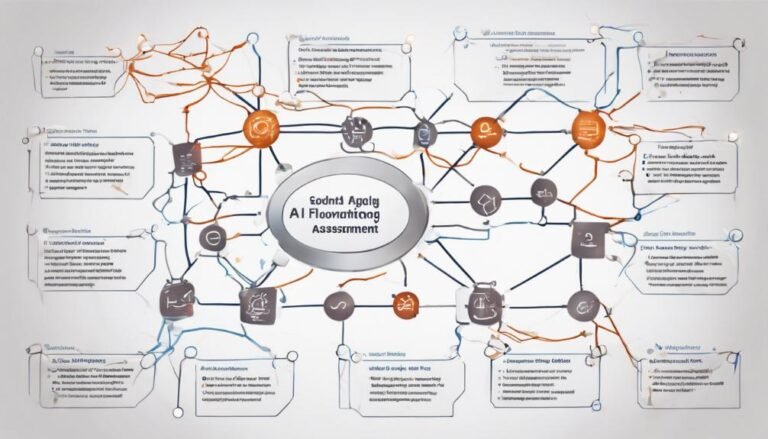AI for Risk Mitigation Strategies
In today's fast-paced and unpredictable business landscape, the need for effective risk mitigation strategies is more critical than ever. Imagine having the power to anticipate potential threats before they even materialize, enabling your organization to stay ahead of the curve and safeguard its operations. AI offers a promising solution to this challenge, revolutionizing how businesses approach risk management. By harnessing the capabilities of artificial intelligence, companies can not only identify risks in real-time but also proactively mitigate them, ultimately enhancing their resilience and competitive edge in the market.
Key Takeaways
- AI analyzes data to forecast risks accurately.
- Machine learning improves risk prediction over time.
- Automated alerts detect potential threats promptly.
- AI implements proactive measures for risk mitigation.
- AI enhances risk management strategies effectively.
The Role of AI in Risk Management
AI plays a pivotal role in modern risk management strategies by leveraging advanced algorithms to analyze complex data sets efficiently. Through AI applications, risk assessment processes have been revolutionized, allowing organizations to identify, evaluate, and prioritize potential risks with remarkable accuracy.
Machine learning, a subset of AI, enables systems to learn from data and improve their ability to predict and mitigate risks over time.
Risk mitigation has greatly benefited from the integration of AI technologies. By utilizing machine learning algorithms, companies can proactively assess risks by detecting patterns and anomalies in data that might go unnoticed by traditional methods. This proactive approach enhances decision-making processes, enabling organizations to implement effective risk mitigation strategies before potential threats escalate.
Enhancing Risk Identification With AI
By integrating advanced algorithms, organizations can greatly enhance their risk identification processes using artificial intelligence. AI offers powerful tools for risk prediction through sophisticated data analysis techniques. By leveraging AI capabilities, organizations can analyze vast amounts of data in real-time to identify potential risks before they escalate.
AI algorithms can sift through intricate datasets to detect patterns and anomalies that might indicate emerging risks. Through machine learning models, AI can continuously learn from new data and adjust risk predictions accordingly. This dynamic approach enables organizations to stay ahead of potential threats and take proactive measures to mitigate risks effectively.
Moreover, AI can provide a more thorough view of risks by analyzing unstructured data sources such as social media, news articles, and industry reports. This broader analysis helps organizations uncover hidden risks that traditional methods might overlook.
Real-Time Risk Monitoring With AI
To enhance risk management strategies further, real-time risk monitoring with AI can provide organizations with immediate insights into potential threats. By utilizing machine learning algorithms, AI systems can continuously analyze vast amounts of data in real-time to detect anomalies and patterns indicative of risks. These algorithms can be trained to recognize various risk factors specific to the organization, enabling the system to generate automated alerts whenever unusual activities or potential threats are identified.
Real-time risk monitoring with AI offers a proactive approach to risk management by allowing organizations to respond swiftly to emerging threats. The automated alerts generated by AI systems can notify relevant stakeholders promptly, enabling them to take immediate action to mitigate the identified risks.
Additionally, the use of machine learning algorithms ensures that the system can adapt and improve its risk detection capabilities over time, enhancing the overall effectiveness of the risk monitoring process. By leveraging AI for real-time risk monitoring, organizations can strengthen their resilience to potential risks and protect their assets more effectively.
Predictive Analytics for Risk Mitigation
Predictive analytics plays an important role in enhancing risk mitigation strategies by utilizing historical data to forecast potential risks and their likelihood of occurrence. Machine learning algorithms are employed to analyze vast datasets, identifying patterns and trends that may indicate future risk scenarios. Through advanced data analysis techniques, predictive analytics can help organizations anticipate and prepare for potential threats before they materialize.
Implementing Proactive Measures Using AI
Utilizing artificial intelligence enables organizations to proactively implement measures to mitigate risks. By harnessing AI technologies, businesses can develop proactive solutions that anticipate potential risks before they escalate into significant issues.
AI implementation allows for the analysis of vast amounts of data in real-time, identifying patterns and anomalies that human analysts might overlook. Through machine learning algorithms, AI systems can continuously learn from new data, enhancing their ability to forecast and prevent risks effectively.
One key advantage of AI in risk mitigation is its capacity to automate the monitoring of various risk factors, providing timely alerts and insights to decision-makers. This proactive approach enables organizations to take preemptive actions to address vulnerabilities and threats promptly.
Additionally, AI-powered risk mitigation tools can offer predictive capabilities, forecasting potential risks based on historical data and current trends. By leveraging AI for proactive risk management, businesses can stay ahead of potential threats, safeguarding their operations and assets effectively.
Benefits of AI in Risk Mitigation
Harnessing artificial intelligence for risk mitigation provides organizations with a strategic advantage by leveraging advanced technologies to anticipate and address potential threats effectively.
One of the primary benefits of utilizing AI in risk mitigation is cost savings. By implementing AI-driven risk mitigation strategies, organizations can streamline processes, automate tasks, and reduce the likelihood of costly incidents. AI algorithms can analyze vast amounts of data quickly and efficiently, enabling organizations to make informed decisions that ultimately lead to financial savings.
Furthermore, AI contributes to improved accuracy in risk assessment and mitigation. Machine learning algorithms can detect patterns and anomalies that may go unnoticed by human analysts, enhancing the overall effectiveness of risk mitigation efforts.
The precision and speed at which AI can process data result in more accurate risk predictions and proactive measures. This heightened accuracy minimizes the margin of error in risk assessment, allowing organizations to respond promptly and effectively to potential threats, ultimately safeguarding their operations and assets.
Conclusion
To sum up, AI serves as a critical ally in fortifying risk mitigation strategies. Picture a dynamic shield constantly analyzing data, detecting threats, and adapting to safeguard your organization in real-time.
By harnessing the power of predictive analytics and proactive measures, AI empowers businesses to stay ahead of risks and maintain a resilient operational environment.
Embrace the future of risk management with AI as your vigilant protector.







